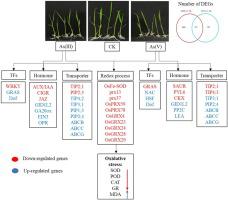Environmental and Experimental Botany ( IF 4.5 ) Pub Date : 2020-12-31 , DOI: 10.1016/j.envexpbot.2020.104366 Xuerong Di , Feng Zheng , Gareth J. Norton , Luke Beesley , Zulin Zhang , Hui Lin , Suli Zhi , Xuncheng Liu , Yongzhen Ding

|
This study examines the molecular response of upland rice when exposed to different inorganic arsenic (iAs) species. One-week-old upland rice (Oryza sativa indica DOURADOAGULHA) seedlings were separately exposed to 100 μM arsenite [As(III)] and arsenate [As(V)] in hydroponic culture for 12 h. Genome-wide transcriptomic analysis revealed that 2983 and 1844 genes were responsive under As(III) and As(V) stresses, respectively. There were 915 shared genes between As(III) and As(V) treatments. Arsenic stress induced changes in complicated gene regulatory pathway of upland rice seedlings, including transcriptional regulation, hormone signaling, redox, transporters and detoxification process. In upland rice separately exposed to As(III) and As(V) for 12, 24, 48 and 72 h, qRT-PCR analysis showed that WRKY4, bHLH and AP2-EREBP associated with transcriptional regulation were significantly down-regulated, while NAC [NAM (no apical meristem), ATAF (Arabidopsis thaliana activating factor) and CUC (cup-shaped cotyledon)] transcription factor was up-regulated. The hormone signaling related gene OZG2, the redox related genes encoding Prx, GST, oxidoreductase and cytochrome P450, the transporter process related genes OsABCC9 and ZIP3 were affected under As stress. Under As(III) and As(V) treatments for 1 and 3 d, the malondialdehyde (MDA) contents in upland rice were increased, while catalase (CAT), peroxidase (POD), superoxide dismutase (SOD) and glutathione reductase (GR) contents were significantly declined. In addition, transcriptomic analysis showed that the genes encoding SOD, Prx, Grx and TrxR were mostly down-regulated. In conclusion, the combination of transcriptome and physiological response may provide a deeper understanding about the molecular mechanism in the response to As in upland rice.
中文翻译:

陆稻暴露于亚砷酸盐和砷酸盐后的生理响应和转录组分析
这项研究检验了陆稻暴露于不同无机砷(iAs)物种时的分子反应。在水培条件下,将一星期大的旱稻(Oryza sativa indica DOURADOAGULHA)幼苗分别暴露于100μM亚砷酸盐[As(III)]和砷酸盐[As(V)] 12 h。全基因组转录组分析显示2983和1844基因分别在As(III)和As(V)胁迫下有反应。As(III)和As(V)处理之间共有915个共享基因。砷胁迫诱导了旱稻幼苗复杂基因调控途径的变化,包括转录调控,激素信号传导,氧化还原,转运蛋白和解毒过程。在分别暴露于As(III)和As(V)12、24、48和72 h的旱稻中,qRT-PCR分析显示与转录调控相关的WRKY4,bHLH和AP2-EREBP被显着下调,而NAC [NAM(无顶端分生组织),ATAF(拟南芥激活因子)和CUC(杯状子叶)]转录因子被上调。激素信号相关基因OZG2,氧化还原相关基因编码Prx,GST,氧化还原酶和细胞色素P450,转运蛋白过程相关基因OsABCC9和ZIP3在As压力下受到影响。在As(III)和As(V)处理1 d和3 d后,陆稻中丙二醛(MDA)含量增加,而过氧化氢酶(CAT),过氧化物酶(POD),超氧化物歧化酶(SOD)和谷胱甘肽还原酶(GR) )含量明显下降。另外,转录组分析表明,编码SOD,Prx,Grx和TrxR的基因大部分被下调。总之,转录组和生理反应的结合可以提供对陆地水稻对砷响应的分子机制的更深入的了解。











































 京公网安备 11010802027423号
京公网安备 11010802027423号